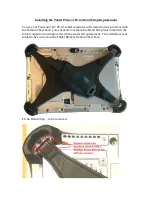
www.balluff.com
11
english
4.2.2 Diameter and position (two edges)
The object is completely within the measuring field, i.e. the
edges of the light band are not covered.
Fig. 4-2: One object (two edges) completely within the light band
For example, selecting Analog output 1 = Pos. Obj. (PO)
and Analog output 2 = Diameter (D) allows the center
position and the diameter to be output simultaneously.
Alternately you can also for example output the position of
both edges:
Analog output 1 = Left Obj.
and
Analog output 2 = Right Obj.
4.2.3 Multiple objects
If there are several objects in the light band, the device
works in such a way that only the first object from the right
and from the left is detected. Objects in between or holes
within an object are ignored.
The output values as shown in Fig. 4-3 are output for diffe-
rent modes in case of multiple objects.
Fig. 4-3: Multiple objects in the light band
4
Parameterization and functions (continued)
4.2.4 Averaging
The averaging function can be used to output the average
of an output value over several cycles. If the parameter is set
to n, the BLA calculates internally the arithmetic average
over n cycles and outputs this average value.If the parame-
ter is set to 1 (or 0), averaging is deactivated and the current
value is output.
4.2.5 Scaling and Offset
The output values can be modified by means of the scaling
and offset values. This is done according to:
Output value = original value x s offset
4.3
Configuration of object detection
The BLA can be used for the detection and differentiation
of individual objects as well as for counting the objects in
the light array.
Detecting and counting modes are to be set together via
the item "detecting mode". The output is via the three
digital outputs or via the process data in IO-Link under the
item object output value.
4.3.1 Detection Modes
Up to six objects to be detected can be set.
If an object is detected, its number is shown in the display
and output via the digital outputs or via the object output
value in the process data.
The same modes are available for object detection as for the
analog output values (the additional modes are explained in
chapter 4.3.2 and 4.3.3). The characteristic value for an
object to be detected (diameter, edge position, …) can be
set by defining the corresponding parameters. For each
object an additional tolerance range can be defined. Both
values are specified in steps of 0.1 mm. Objects located in
the light band can be taught in via the display menu.
If the parameter behind the object number is set to "T"
(Teach) in the menu under Output settings
Digital outputs
and is confirmed, the current value is automatically accep-
ted.
If the parameter is set to "+" the value can only be set
manually. The corresponding object number is deactivated
by selecting "-".
Fig. 4-4: Menu display digital outputs
BLA Series D
Balluff Light Array
Summary of Contents for IO-Link BLA 100D-001-S115
Page 2: ...www balluff com...
Page 47: ......














































